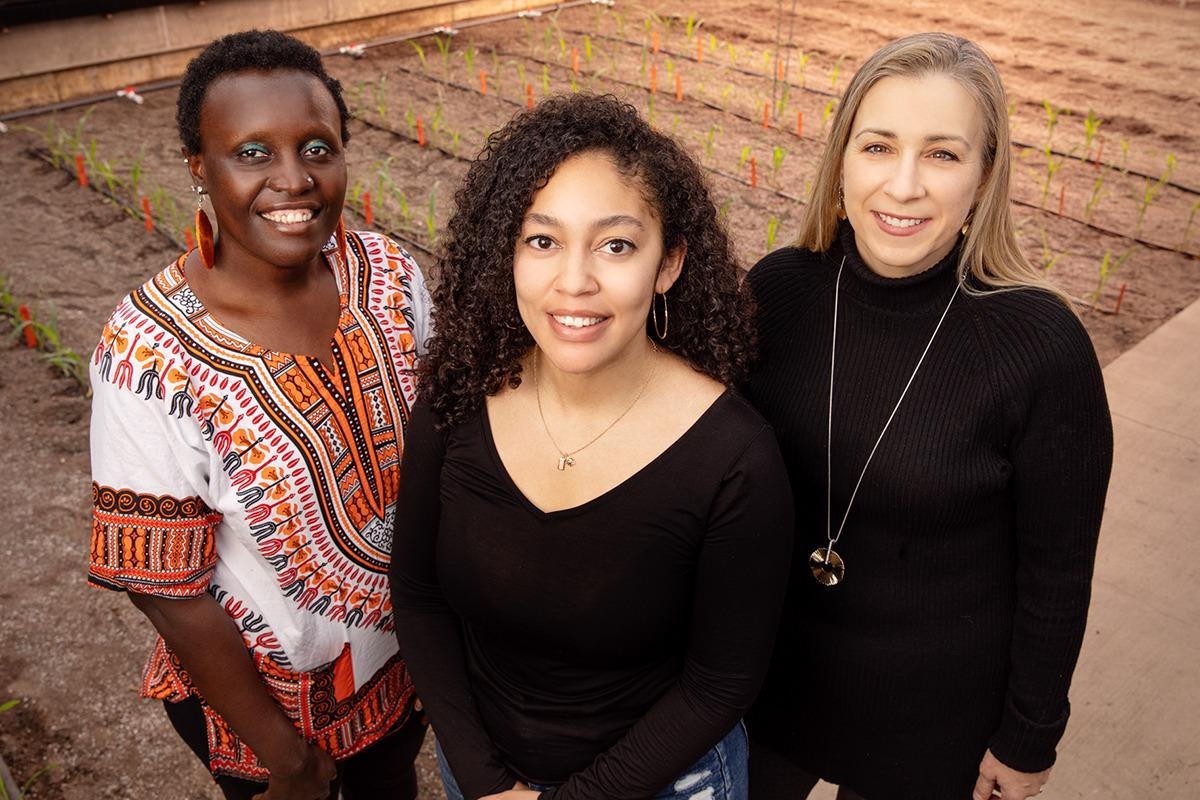When plants are attacked by chewing insects, they produce chemical distress signals. As entomologist Esther Ngumbi puts it, these “911 cries” inform other bugs that a meal or a great site to lay their eggs is approaching. When predatory or parasitic insects detect the correct signal, they rush in like saviors to eat—or deposit their eggs in—the herbivore insects’ bodies.
 Researchers, from left, U. of I. entomology professor Esther Ngumbi, PhD candidate Sierra Raglin, and natural resources and environmental sciences professor Angela Kent compared how different corn varieties responded to chewing insects in the presence of a soil bacterium. Image Credit: Photo by L. Brian Stauffer.
Researchers, from left, U. of I. entomology professor Esther Ngumbi, PhD candidate Sierra Raglin, and natural resources and environmental sciences professor Angela Kent compared how different corn varieties responded to chewing insects in the presence of a soil bacterium. Image Credit: Photo by L. Brian Stauffer.
New research compares how various corn types respond to herbivory in the presence or absence of a soil bacteria known to boost plant health, to see what elements contribute to corn plants’ chemical signaling capabilities.
Ngumbi, an entomology professor at the University of Illinois Urbana-Champaign, co-led the study with Angela Kent, a University of Illinois natural resources and environmental sciences professor, and Sierra Raglin, a PhD candidate and the paper’s first author. Frontiers in Microbiology published the research findings.
According to Kent, research into plant-microbial interactions is becoming increasingly popular among farmers looking to boost crop output and resilience.
The plant microbiome holds great promise for improving the sustainability of crop production. Our research is aimed toward treating the microbiome and its sustainability functions as a plant trait.”
Angela Kent, Professor, Natural Resources and Environmental Sciences, University of Illinois Urbana-Champaign
Raglin stated, “The bacterium we tested, Bacillus altitudinus, has numerous plant growth-promoting characteristics. It also is known to help plants tolerate stresses such as drought or heavy metals in the soil.”
Raglin claims that this and other soil bacteria alter gene expression in plant tissues and increase immune responses. “We wanted to see if this microbe also influenced plants’ release of volatile compounds,” Raglin added.
In a greenhouse experiment, the researchers produced six types of corn in living or sterile soil. Before sowing, some of the corn seeds were injected with the bacillus. The scientists exposed the corn plants to corn earworm larvae after four weeks, allowing the caterpillars to eat for 24 hours before collecting and evaluating the volatile chemicals released by the plants.
The researchers discovered that the six corn kinds they studied had diverse responses to munching bugs. Some kinds produced a larger number of volatile chemicals or a wider variety of volatile compounds than others. The presence or absence of the bacteria seemed to not affect the reactions.
Only one species of maize appeared to increase its total synthesis of volatile chemicals in response to the soil microorganism. The researchers say that further study is needed to see if this improves its defenses.
The soil bacteria had another impact, according to the researchers: it enhanced plant development when maize was cultivated under sterile circumstances. This circumstance, however, would not apply to field-grown corn, according to the researchers.
According to Raglin, the findings are preliminary, and additional work is needed to separate the complicated linkages.
Even in an agricultural setting, the environment is complex.”
Sierra Raglin, Study First Author and PhD Candidate, Department of Natural Resources and Environmental Sciences, University of Illinois Urbana-Champaign
The soil bacteria studied is just one of many microbes in a complex network, and many other factors can impact how plants respond.
We don’t want to overstate the role that any one factor contributes. Every contributor to this interaction—the plant, the microbes, the soil—has a part to play. Care must be taken to ensure that you understand the contribution of every partner.”
Esther Ngumbi, Professor, Departments of Entomology, University of Illinois Urbana-Champaign
Source:
Journal reference:
Raglin, S. S., et al. (2022) Herbivory Protection via Volatile Organic Compounds Is Influenced by Maize Genotype, Not Bacillus altitudinis-Enriched Bacterial Communities. Frontiers in Microbiology. doi.org/10.3389/fmicb.2022.826635.